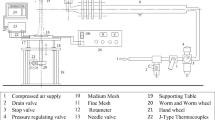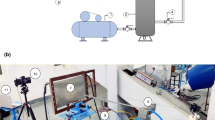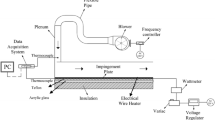Abstract
Experiments are carried out for a circular orifice and a nozzle for the same contraction ratio to explore the heat transfer characteristics. The pressure ratios covered in this study are 2.36, 3.04, 3.72, 4.4 and 5.08 for jet to plate distances (z/d) of 2, 4, 6 and 8. The presence of vena contracta and absence of the stagnation bubble in the orifice flow are confirmed from the surface pressure distributions. It is found that higher Nusselt number for the orifice than the nozzle are due to different shock structures and shear layer dynamics. Peak Nusselt number is found as high as 84 % than that for the nozzle. In the wall jet region, the heat transfer rates for the orifice and nozzle are almost of the same order, thus producing steeper temperature gradients under similar operating conditions. The average heat transfer rates are almost 25 % higher for the orifice than that of the nozzle. The recovery factors are in general higher in case of orifice than the nozzle. However, this has not resulted in decreasing the heat transfer rates due to shear layer dynamics.











Similar content being viewed by others
Abbreviations
- A :
-
Surface area of the target plate (m2)
- C p :
-
Specific heat at constant pressure of the air (kJ/kg K)
- C d :
-
Coefficient of discharge of orifice/nozzle
- d :
-
Throat diameter of the nozzle (m)
- h :
-
Heat transfer coefficient (W/m2 K)
- I :
-
Current (Amperes)
- k :
-
Thermal conductivity of the air (W/m K)
- M :
-
Design Mach number at the nozzle exit plane
- NPR :
-
Nozzle pressure ratio (P o /P ∞ )
- Nu :
-
Nusselt number (hd/k)
- P :
-
Surface pressure at a given radial location (Pa)
- P o :
-
Total pressure at the inlet of the nozzle (Pa)
- P ∞ :
-
Ambient pressure (Pa)
- P exit :
-
Pressure at the exit of the nozzle (Pa)
- q conv :
-
Net heat flux convected to the impinging jet (W/m2)
- q joule :
-
Imposed Ohmic heat flux (VI/A) (W/m2)
- q loss :
-
Total heat flux loss from impingement plate (W/m2)
- q rad(f) :
-
Radiation heat loss from the front surface of impingement plate (W/m2)
- q rad(b) :
-
Radiation heat loss from the back surface of impingement plate (W/m2)
- q nat :
-
Heat loss by natural convection from the back surface of impingement plate (W/m2)
- r :
-
Radial distance from the stagnation point (m)
- R :
-
Recovery factor
- Re :
-
Reynolds number (ρ \( \bar{V} \) d/μ)
- T r :
-
Temperature of the target plate at a given radial location (°C)
- T aw :
-
Adiabatic temperature of the target plate at a given radial location (°C)
- T s :
-
Jet static temperature (°C)
- T d :
-
Jet dynamic temperature (°C)
- T 0 :
-
Jet total temperature (°C)
- V :
-
Voltage (V)
- \( \bar{V} \) :
-
Average velocity at the exit of the nozzle/orifice (m/s)
- z :
-
Nozzle to plate spacing (m)
- β :
-
Constriction ratio (diameter of the throat/diameter of the pipe)
- ρ :
-
Density of the air corresponding to supply pressure (kg/m3)
- μ :
-
Dynamic viscosity of the air (Pa s)
- γ :
-
Specific heat ratio of the air
References
Mi J, Nathan GJ, Nobes DS (2001) Mixing characteristics of free jets from a contoured nozzle, an orifice plate, and a pipe. J Fluids Eng Trans ASME 123:878–883
Antonia RA, Zhao Q (2001) Effect of initial conditions on a circular jet. Exp Fluids 31:319–323
Lee J, Lee SJ (2000) The effect of nozzle configuration on stagnation region heat transfer enhancement of axisymmetric jet impingement. Int J Heat Mass Transf 43:3497–3509
Quinn WR (2006) Upstream nozzle shaping effects on near field flow in round turbulent free jets. Eur J Mech B Fluid 25:279–301
Deo RC, Mi J, Nathan GJ (2007) The influence of nozzle aspect ratio on plane jets. Exp Thermal Fluid Sci 31:825–838
Deo RC, Mi J, Nathan GJ (2008) The influence of Reynolds number on a plane jet. Phys Fluids 20:075108
Shakouchi T, Kito M, Sakamoto T, Tsujimoto K, Ando T (2009) Flow control of jet flow by passive nozzle configuration changes. Int J Flow Control 1(1):73–85
Garimella SV, Nenaydykh B (1996) Nozzle geometry effects in liquid jet impingement heat transfer. Int J Heat Mass Transf 39(14):2915–2923
Lee J, Lee SJ (2000) The effect of nozzle configuration on stagnation region heat transfer enhancement of axisymmetric jet impingement. Int J Heat Mass Transf 43:3497–3509
Zhou DW, Lee SJ (2004) Heat transfer enhancement of impinging jets using mesh screens. Int J Heat Mass Transf 47:2097–2108
Henderson LF (1966) Experiments on the impingement of a supersonic jet on a flat plate. Z Angew Math Phys 17:553–569
Meola C, de Luca L, Carlomagno GM (1995) Azimuthal instability in an impinging jet: adiabatic wall temperature distribution. Exp Fluids 18:303–310
Yaga M, Ueda K, Ohshiro T, Senaha I, Oyakawa K (2000) Experimental and three-dimensional numerical study on under-expanded impinging jets. J Therm Sci 9(4):316–321
Kim BG, Yu MS, Cho YI, Cho HH (2002) Distributions of recovery temperature on flat plate by underexpanded supersonic impinging jet. J Thermophys Heat Transf 16(3):425–431
Kim BG, Yu MS, Cho HH (2003) Recovery temperature measurement of underexpanded sonic jets impinging on a flat plate. J Thermophys Heat Transf 17(3):313–319
Yu MS, Kim BG, Cho HH (2005) Heat transfer on flat surface impinged by an underexpanded sonic jet. J Thermophys Heat Transf 19(4):448–454
Ramanujachari V, Vijaykant S, Roy RD, Ghanegaonkar PM (2005) Heat transfer due to supersonic flow impingement on a vertical plate. Int J Heat Mass Transf 48:3707–3712
Inman JA, Danehy PM, Nowak RJ, Alderfer DW (2008) Fluorescence imaging study of impinging underexpanded jets. In: AIAA-2008-619, 46th AIAA aerospace sciences meeting and exhibit, Nevada
Gibbings JC (1966) The combination of a contraction with a supersonic nozzle for a wind tunnel. Ingenieur Arch 35(4):269–275
Rahimi M, Owen I, Mistry J (2003) Impingement heat transfer in an under-expanded axisymmetric air jet. Int J Heat Mass Transf 46:263–272
Lytle D, Webb BW (1994) Air jet impingement heat transfer at low nozzle plate spacings. Int J Heat Mass Transf 37:1687–1697
Moffat RJ (1988) Describing the uncertainties in experimental results. Exp Thermal Fluid Sci 1:3–17
Donaldson CD, Snedeker RS (1971) A study of free jet impingement part 1. Mean properties of free and impinging jets. J Fluid Mech 45(2):281–319
Iwamoto J, Deckker BEL (1981) Development of flow field when a symmetrical under-expanded sonic jet impinges on a flat plate. J Fluid Mech 113:299–313
Sarvothathama Jyothi TJ (2009) Acoustic characteristics of under-expanded free jets from orifices and pipes. Ph D thesis, IIT Chennai, India
Mi J, Kalt P, Nathan GJ, Wong CY (2007) PIV measurements of a turbulent jet issuing from round sharp-edged plate. Exp Fluids 42:625–637
Liepmann D, Gharib M (1992) The role of streamwise vorticity in the near-field entrainment of round jets. J Fluid Mech 245:643–668
Sutera SP, Maeder PF, Kestin J (1963) On the sensitivity of heat transfer in the stagnation point boundary layer to free stream vorticity. J Fluid Mech 16(4):497–520
Bae S, Lele SK, Sung HJ (2000) Influence of inflow disturbances on stagnation region heat transfer. ASME J Heat Transf 122:258–265
Bae S, Lele SK, Sung HJ (2003) Direct numerical simulation of stagnation region flow and heat transfer with free-stream turbulence. Phys Fluids 15:1462–1484
Gifford AR, Diller TE, Vlachos PP (2011) The physical mechanism of heat transfer augmentation in stagnating flows subject to free-stream turbulence. Trans ASME J Heat Transf 133:021901-1–021901-10
Fox MD, Kurosaka M, Hedges L, Hirano K (1993) The influence of vortical structures on the thermal fields of jets. J Fluid Mech 255:447–472
Lou H, Shih C, Alvi FS (2003) A PIV study of supersonic impinging jet. In: 9th AIAA/CEAS aeroacoustics conference and exhibit, May 2003, South Carolina
Author information
Authors and Affiliations
Corresponding author
Rights and permissions
About this article
Cite this article
Limaye, M.D., Vedula, R.P. & Prabhu, S.V. Comparison of heat transfer distributions on a flat plate impinged by under-expanded jets from a convergent nozzle and a circular orifice. Heat Mass Transfer 49, 309–326 (2013). https://doi.org/10.1007/s00231-012-1089-4
Received:
Accepted:
Published:
Issue Date:
DOI: https://doi.org/10.1007/s00231-012-1089-4




